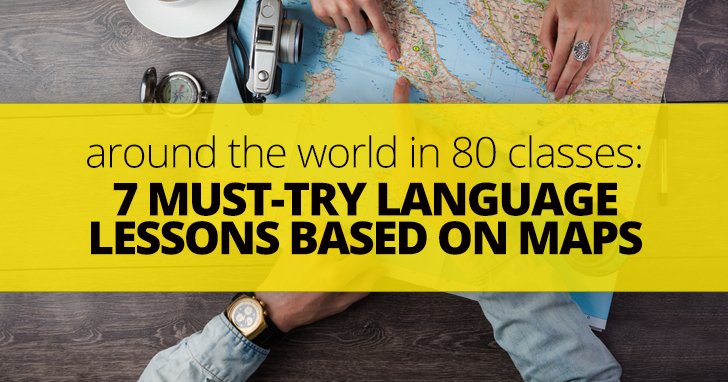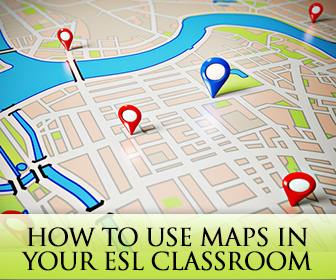Around the World in 80 Classes: 7 Must-try Language Lessons Based on Maps


In fact, most people would probably be surprised to hear that maps can be quite useful for students of English as a second language. Maps are visually based, but you can do so many linguistic activities with them. With a little creativity and direction, maps can be the starting point for all kinds of creative language practice in the ESL classroom. Here are some of my favorite ways for using maps in my ESL classes.

Directional words can be challenging for many ESL students. North, south, east and west can be elusive, but even words as simple as right and left are worth practicing. Maps can provide the material for a listening comprehension activity for reviewing directional words like these as well as straight, turn around, backwards, backtrack and stop. To give them the listening practice they need, give each student a copy of a map (either an authentic map or one you have created). Announce the starting point (often the location of your class) and then give your students a set of oral directions. “Go straight three blocks. Turn left.” As you give the directions, they should follow along on their maps. Once you have given all the directions, ask your students where they are on the map by pointing to it or marking it on their copies. You can extend this activity as well by practicing locational prepositions. Follow the same procedure as above, but this time give directions like, “Turn after the library.” You will have a clear understanding of who understood your directions and who still needs practice with directional words and prepositions of location.
Believe it or not, maps are a great way to practice the conditional tense, too. Starting with a map filled with interesting locations, ask your students where they would like to travel for vacation. Ask your students to plan their vacation, where they would go, how they would get there, what they would do and what they would bring with them. You could ask students to write out their plans or give a presentation to the class. You might even want to display the map in your classroom and then post your students’ travel plans near the locations they chose. If you like, extend the lesson to reading and research practice by having students gather additional information about their vacation destination.
Creating your own cities is a popular pastime. (If you don’t believe me, just look at all the SIM games available on the market.) Your students may enjoy the group activity of creating their own towns. Working in groups of three or four, have students create a layout and then map of their ideal town. This activity not only gives students conversation practice as they work with their classmates. It is also a great way to practice vocabulary associated with locations. Instruct your students to include all the locations a town could need: restaurant, school, shopping mall or department store, library, gas station, residences, hospital and any others you choose to include in your vocabulary unit. Have students diagram their towns on poster board and then display them in your classroom or along the hallway. You can also have your class vote on the town they would most like to live in. (They should not be allowed to choose their own.) Extend the activity by having students write about the town they would choose and why.
With a class full of international students, talking about countries and cultures is a must. Use a map to help your class become familiar with their classmates’ home countries. (If you are teaching a class overseas, you can have your students research different countries of the world rather than talking about their home country.) Have your intermediate or advanced students give a five minute presentation on their home country using a world map or a map of their country. Students should talk about popular locations and what makes their culture unique. To extend the activity, have students talk about the geographical makeup of their home country. Review geography terms with your class (desert, mountains, river, ocean, etc.) and then challenge them to use as many as possible in their presentation. Leave the maps posted in your classroom, and then when you test on the geographical vocabulary ask your students to name a country with certain geographical components.
Encourage your students to take a vacation in their minds by choosing a location on the map to visit. Have students do research and then write as if they were at their vacation location. They should research the weather and things to do at their vacation spot. You may want to have students write post cards or letters to family describing the place (you can find instructions on how to teach personal letters here) or have students write imaginary journal entries about their vacation. To extend the activity, you could also have students write a tourism pamphlet encouraging others to visit their location. If you do, post these around your classroom and let your students read each other’s work.
Essays are a big part of academic English programs, and none is more common than the compare/contrast essay. You can use maps to serve as inspiration for your students’ essays by displaying a historical map and a modern map of the same location. Most history classrooms have these historical maps, but you can also find them on line. Ask your students to study both map and then write about how the place has changed over time using the compare/contrast essay format. To extend the activity, have students make predictions about how the same area may change in the future.
I have found that maps are extremely useful in giving my students interesting ways to practice the language that they are learning as well as introducing them to new and useful vocabulary. In an ideal world, I would have the budget to take my students to the most interesting places in the world and then have them use those experiences as inspiration. Until then, I’ll keep my maps and keep challenging my students to use them to expand their English language skills.
How do you use them?